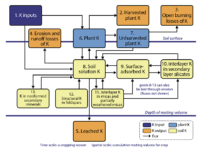
The California almond industry confronted the challenges facing the industry at this year’s Almond Conference while also offering up a number of solutions to help the industry move forward. While some of the industry’s challenges are external—water, crushing supply chain disruptions, increases in input costs—others are self-imposed, namely a precarious imbalance in supply and demand.
Several sessions at this year’s first in-person conference in two years focused on efforts to build demand, through novel approaches to domestic marketing and building and expanding on important export markets. In addition, a well-attended session on breaking the export log jam focused on the supply chain issues impacting the industry and how or when it will ever be resolved. Experts at this year’s Almond Industry conference seemed to agree that the way out of the current price situation for almond growers is through it, by balancing out supply and demand and building relationships to break down obstacles at home and abroad.
Supply Chain Issues
In a session titled Ag Export Delays: Any Light at the End of the Tunnel, the Almond Board’s Geoff Bogart noted that there is a dim light but it is a very long tunnel. As of early December the situation at ports, rail ramps and roads continued to deteriorate causing delays in shipments, according to Joshua Woods of Blue Diamond Growers.
Jonathan Hoff at Monte Vista Farming, said the crisis is creating a cash conversion cycle longer than ever before, making it harder to pay growers in a timely manner.
“It’s critical we figure out this puzzle and that we keep things going. The issues we are facing are huge and its going to require a massive effort from every stakeholder that is involved,” said Hoff, chair of the ABC Technical and Regulatory Affairs Committee.
Katie Stack, with Grizzly Nut and the board of directors of the Almond Alliance, said the Alliance is focusing on getting empty containers filled with almonds and back on vessels. That includes strategies to store almonds closer to ports, break the log jam in trucks and chassis and develop strategic partnerships with labor and trucking groups.
Andrew Hwang of the Port of Oakland said that California almonds are an important segment for the port and that congestion at the port is being exacerbated by a shortage of trucks and containers. He stressed that the crisis should compel companies to shore up their logistics planning now and in the future.
“Logistics has been looked on as a pass through part of the business, but companies who have traditionally complex logistics programs have been hurt less, so there needs to be a strategic alignment of logistics programs with the rest of the business,” Hwang advised.
Brian Ezell of the Wonderful Company and chair of ABC’s Global Market Development Committee, said these unprecedented transportation and port issues continue to plague shipments.

“We started feeling the pains of it about a year ago, but I kind of felt like as an industry, we had learned some tricks, and knew how to deal with the issues and we had record shipments month after month,” Ezell said. But recent months have become much tougher.
Ezell said that while external forces such as water, tariffs, transportation issues and input costs are external and beyond the growers’ control, supply issues must still be addressed. A supply increase of 37 percent over the last two years is not sustainable. Ezell said the industry is built to absorb a supply growth rate of about 6.5 to 7 percent before efforts to build demand can no longer offset that growth and prices suffer.
Exports Lead the Way
Meanwhile global demand for almonds, despite these trade and logistics challenges, continues to be a bright spot for the industry. About 70 percent of California almonds are destined for export markets. ABC’s Emily Fleishman said strategic marketing objects to build long-term worldwide demand will help buoy the financial well being of the industry. The Almond Board works to choose the right markets currently and in the future to build demand. She said the Board is looking beyond growth in the top 10 markets to new regions including South American, the Middle East, Africa and even Russia, to build demand for future production.
While conditions on the ground and at sea have been challenging for exports, those markets will continue to lead the way for California almond handlers. India is particularly hopeful in terms of its place as the number one export market for California almonds, and in terms of its untapped market potential.
“The India market is tailor made for our industry,” according to Warren Cohen, VP of global sales for Blue Diamond Growers. Almonds fit well into India’s health conscious eating trends and there are vast areas of India that have not yet been touched by the market potential of California almonds.
Consumption in India saw a 42 percent increase in one year and while there are several kinks in the trade relationship, consumption is still higher than that for all EU nations combined. While India has a number of trade challenges, US trade representatives are working to set the stage for regular engagement on trade with India, said Joan Hurst with the USDA’s Foreign Ag Service.
A growing middle class and improved economy and infrastructure are removing access barriers to Indian consumers.
“The good news is there is still so much potential and upside to be had in the market,” Fleishman said.
Domestic Growth
Domestic market growth will also be key to continued industry success and Fleishman noted that younger consumers will be an important target for domestic marketing programs. The Almond Board plans to engage millennials through a partnership with Marvel Studios featuring a cross promotion with the upcoming Thor “cinematic universe”.
Fleishman said that while almonds are a $30 billion global category in grocery stories it has the potential to exceed $164 billion within a decade.

Marni Katz
Marni Katz has lived and raised her family in the San Joaquin Valley for nearly 30 years. In that time, she has covered agriculture for a number of leading ag publications and organizations and gained a reputation for understanding and digesting complex information and presenting it to growers. She enjoys learning about new ways growers can farm more profitably and efficiently, and working with researchers and stakeholders to bring that information to the growing community. In her free time, Marni plays saxophone with jazz groups throughout the Valley and is an avid tennis nut.















